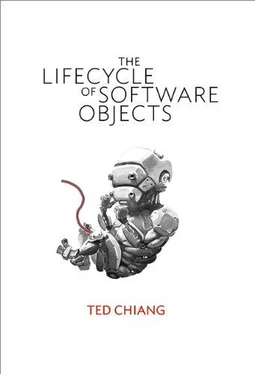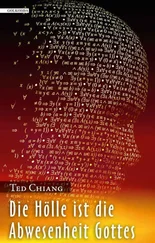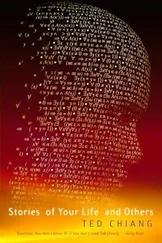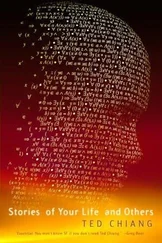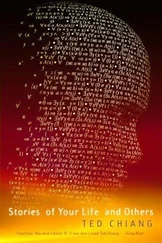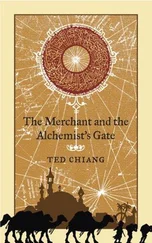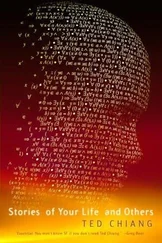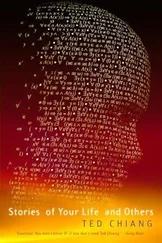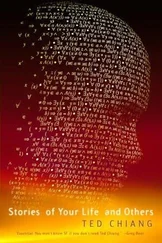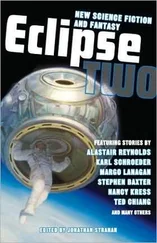The researchers conclude that there’s something missing in the Origami genome, but as far as Derek’s concerned, the fault lies with them. They’re blind to a simple truth: complex minds can’t develop on their own. If they could, feral children would be like any other. And minds don’t grow the way weeds do, flourishing under indifferent attention; otherwise all children in orphanages would thrive. For a mind to even approach its full potential, it needs cultivation by other minds. That cultivation is what he’s trying to provide for Marco and Polo.
Marco and Polo occasionally get into arguments, but they don’t stay angry for very long. A few days ago, however, the two of them got into a fight over whether it was fair that Marco had been instantiated earlier than Polo, and for some reason it escalated. The two digients have hardly spoken to each other since, so Derek’s relieved when they approach him as a pair.
“It’s nice to see you two together again. Have you guys made up?”
“No!” says Polo. “Still angry.”
“I’m sorry to hear that.”
“Both us want your help,” says Marco.
“Okay, what can I do?”
“Want you roll back us last week, before big fight.”
“What?” This is the first time he’s ever heard of a digient requesting to be restored from a checkpoint. “Why would you want that?”
“I want not remember big fight,” says Marco. “I want be happy, not angry,” says Polo.
“You want us be happy, right?”
Derek opts not to get into a discussion about the difference between their current instantiations and instantiations restored from a checkpoint. “Of course I do, but I can’t just roll you back every time you have a fight. Just wait a while, and you won’t be so angry.”
“Have waited, and still angry,” says Polo. “Fight big big. Want it never happen.” As soothingly as he can, Derek says, “Well, it did happen, and you’re going to have to deal with it.”
“No!” shouts Polo. “I angry angry! Want you fix it!”
“Why you want us stay angry forever?” demands Marco.
“I don’t want you to stay angry forever, I want you to forgive each other. But if you can’t, then we’ll all have to live with that, me included.”
“Now angry at you too!” says Polo.
The digients storm off in different directions, and he wonders if he’s made the right decision. It hasn’t always been easy raising Marco and Polo, but he’s never rolled them back to an earlier checkpoint. This strategy has worked well enough so far, but he can’t be certain it will keep working.
There are no guidebooks on raising digients, and techniques intended for pets or children fail as often as they succeed. The digients inhabit simple bodies, so their voyage to maturity is free from the riptides and sudden squalls driven by an organic body’s hormones, but this doesn’t mean that they don’t experience moods or that their personalities never change; their minds are continuously edging into new regions of the phase space defined by the Neuroblast genome. Indeed, it’s possible that the digients will never reach “maturity”; the idea of a developmental plateau is based on a biological model that doesn’t necessarily apply. It’s possible their personalities will evolve at the same rate for as long as the digients are kept running. Only time will tell.
Derek wants to talk about what just happened with Marco and Polo; unfortunately, the person he wants to talk to isn’t his wife. Wendy understands the possibilities for the digients’ growth, and recognizes that Marco and Polo will become more and more capable the longer they’re cared for; she simply can’t generate any enthusiasm about that prospect. Resentful of the time and attention he devotes to the digients, she would consider their request to be rolled back the perfect opportunity to suspend them for an indefinite period.
The person he wants to talk to is, of course, Ana. What once seemed a groundless fear of Wendy’s has come true; he has definitely developed feelings for her beyond friendship. It’s not the cause of the problems he’s having with Wendy; if anything, it’s a result. The time he spends with Ana is a relief, a chance for him to enjoy the digients’ company unapologetically. When he’s angry he thinks it’s Wendy’s fault for driving him away, but when he’s calm he realizes that’s unfair.
The important thing is that he hasn’t acted on his feelings for Ana, and he doesn’t plan to. What he needs to focus on is reaching an accord with Wendy regarding the digients; if he can do that, the temptation that Ana poses should pass. Until then, he ought to reduce the amount of time he spends with Ana. It’s not going to be easy: given how small the digient-owner community is, interaction with Ana is inevitable, and he can’t let Marco and Polo suffer because of this. He’s not sure what to do, but for now, he refrains from calling Ana for advice and posts a question to the forum instead.
Another year passes. Currents within the mantle of the marketplace change, and virtual worlds undergo tectonic shifts in response: a new platform called Real Space, implemented using the latest distributed-processing architecture, becomes the hot-spot of digital terrain formation. Meanwhile Anywhere and Next Dimension stop expanding at their edges, cooling into a stable configuration. Data Earth has long been a fixture in the universe of virtual worlds, resistant to growth spurts or sharp downturns, but now its topography begins to erode; one by one, its virtual land masses disappear like real islands, vanishing beneath a rising tide of consumer indifference.
Meanwhile, the failure of the hothouse experiments to produce miniature civilizations has caused general interest in digital lifeforms to dwindle. Occasionally curious new fauna are observed in the biomes, a species demonstrating an exotic body plan or a novel reproductive strategy, but it’s generally agreed that the biomes aren’t run at a high enough resolution for real intelligence to evolve there. The companies that make the Origami and Faberge genomes go into decline. Many technology pundits declare digients to be a dead end, proof that embodied AI is useless for anything beyond entertainment, until the introduction of a new genomic engine called Sophonce.
Sophonce’s designers wanted digients that could be taught via software instead of needing interaction with humans; toward that end, they’ve created an engine that favors asocial behavior and obsessive personalities. The vast majority of the digients generated with the engine are discarded for their psychological malformations, but a tiny fraction prove capable of learning with minimal supervision: give them the right tutoring software and they’ll happily study for weeks of subjective time, meaning that they can be run at hothouse speeds without going feral. Some hobbyists demonstrate Sophonce digients that outperform Neuroblast, Origami, and Faberge digients on math tests, despite having been trained with far less real-time interaction. There’s speculation that, if their energies can be directed in a practical direction, Sophonce digients could become useful workers within a matter of months. The problem is that they’re so charmless that few people want to engage in even the limited amounts of interaction that the digients require.
#
Ana has brought Jax along with her to Siege of Heaven, the first new game continent to appear in Data Earth in a year. She shows him around the Argent Plaza, where players congregate and socialize in between missions; it’s a massive courtyard of white marble, lapis lazuli, and gold filigree located on top of a cumulonimbus cloud. Ana has to wear her game avatar, a kestrel-cherub, but Jax keeps his traditional copper robot avatar.
Читать дальше
